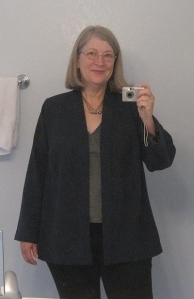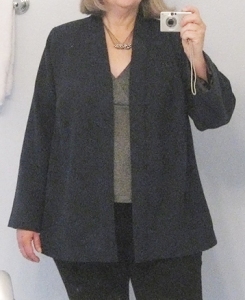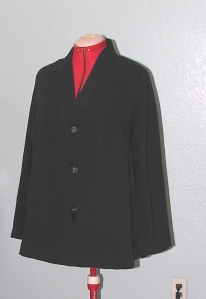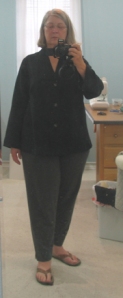Pendleton Woolen Mills has issued a sewing pattern based on their iconic “49’er” jacket.
 This is the description from the back of the envelope: The Pendleton 1949 Jacket is based on the original Pendleton ’49er. It is an unstructured, unlined jacket with a straight hem. Button front has a French Placket and peaked lapels. Flanged shoulders allow ease of movement. Long sleeves are finished with single-button rounded cuffs. Two open patch pockets can be cut on the bias, matched to grain or omitted.
This is the description from the back of the envelope: The Pendleton 1949 Jacket is based on the original Pendleton ’49er. It is an unstructured, unlined jacket with a straight hem. Button front has a French Placket and peaked lapels. Flanged shoulders allow ease of movement. Long sleeves are finished with single-button rounded cuffs. Two open patch pockets can be cut on the bias, matched to grain or omitted.
In the past, I’ve used camp-style shirt patterns to try to replicate this style, just doing my best to copy that shoulder flange that is one of the key features.
This was a very nostalgic project for me, because I have very clear memories of my mother wearing a jacket like this. Hers was a muted pale green, and was probably a knock-off. I wasn’t too keen on mother/daughter outfits back in the day, but now I’m happy that I can wear something like she did.
 Mine is a screaming purple, though, because I have had this wool crepe in the stash for a long, long time. I ordered it because I knew that it was the good stuff…and was surprised when it arrived and was such a vivid color. I was never going to make it into anything else, so it became the fabric for a test version of this pattern.
Mine is a screaming purple, though, because I have had this wool crepe in the stash for a long, long time. I ordered it because I knew that it was the good stuff…and was surprised when it arrived and was such a vivid color. I was never going to make it into anything else, so it became the fabric for a test version of this pattern.
I’m really happy to have this pattern and don’t want to be overly critical. After all, Pendleton is a fabric mill, not a pattern company. But I do want to mention a few things that were lacking in the pattern as a heads up for others that might want to make it.
Fabric layouts – the back of the envelope reminds you that you need extra to match plaids. I was surprised, though, that the layout diagrams for 60″ fabric has the sleeve cut out crossways. If your plaid is uneven, I don’t think that would work.
That instructions for that important shoulder flange were not very clear, and even though I can’t figure out a different way to make them, I’m still not sure that I got it right. The tissue has edgestitching marked for the edge of the flange, but it doesn’t seem to be complete or meet up where it should. I am curious to find out if others see this same omission. It could very well be that I just missed some vital info somewhere.
 Some other markings or instructions seem to be missing and would be helpful. There was no match point on the sleeve cap for the shoulder seam, for instance. And there was some topstitching indicated in the diagrams that was never mentioned in the instructions. The diagram showing the topstitching on the lapel looked wrong, to me. Button size was not given. Since some people will be sewing to replicate the real thing, button size would be nice to know.
Some other markings or instructions seem to be missing and would be helpful. There was no match point on the sleeve cap for the shoulder seam, for instance. And there was some topstitching indicated in the diagrams that was never mentioned in the instructions. The diagram showing the topstitching on the lapel looked wrong, to me. Button size was not given. Since some people will be sewing to replicate the real thing, button size would be nice to know.
However, this was not difficult at all to sew, except for wondering about the construction of the shoulder flange. And they gave separate pattern pieces for interfacing, which is a nice touch.
My fabric was a touch too beefy for the continuous lap on the sleeve placket, especially where the placket and cuff come together. So my greatest sewing challenge was due to selecting the wrong fabric. I do love the very heavy drape of the crepe, though.
Alterations: I increased the width of the back by making the uptake of the pleats larger. (the back is pleated into a yoke at each shoulder blade) I also shortened the sleeves 1″, and could have made them even a little shorter. Next time I will narrow the shoulders a little and think that will help set the flange. It gapes a little if I don’t maintain good posture. Meanwhile, some shoulder pads will help and there is plenty of time to put them in before cold weather gets here.
I followed the instructions and am glad I did. I would have done a burrito assembly for the yoke. Their method, although it required a little hand stitching, prevents any boo-boos around the neck edge and I was glad to have that come out perfect. I sneaked in some understitching that was not called for, but makes for a nicer finish around the back of the collar and at the front edges. I also did the topstitching on the lapel and collar the way I thought it should be, not the way they showed in the diagram.
 I ended up loving the color made up in this style, and think I will wear it a lot once the weather is right. It’s still nearly 100 in the afternoons here, but cooler temperatures will come. Eventually I’d like to buy the correct fabric from Pendleton in a lovely plaid and make another one.
I ended up loving the color made up in this style, and think I will wear it a lot once the weather is right. It’s still nearly 100 in the afternoons here, but cooler temperatures will come. Eventually I’d like to buy the correct fabric from Pendleton in a lovely plaid and make another one.
The sleeve looks twisted in this photo but that’s just the result of taking an awkward mirror selfie.
My pattern came with a fun booklet highlighting styles of the 1900s by decade. If you’re interested in the pattern, here’s a link: 1949 Jacket Pattern

 On an Ottobre kick. My MO for this project was to pick a stash fabric that I really wanted to make up – in this case a coarsely woven ikat – and pick a pattern that would make the best use of it.
On an Ottobre kick. My MO for this project was to pick a stash fabric that I really wanted to make up – in this case a coarsely woven ikat – and pick a pattern that would make the best use of it. Not crazy about the buttons. JoAnns used to have a pretty good selection, but not any more. For shirts, that’s no problem. I go to the thrift store and for $1 buy a shirt with buttons I like. It’s not so easy with jacket buttons. So I bought some plain white ones at JA, even though they were shiny. Before sewing them on, I scuffed them up with sandpaper to remove the shine, because it just didn’t go well with the rustic weave. They are still too white, and one day when I have a better button selection I will replace them.
Not crazy about the buttons. JoAnns used to have a pretty good selection, but not any more. For shirts, that’s no problem. I go to the thrift store and for $1 buy a shirt with buttons I like. It’s not so easy with jacket buttons. So I bought some plain white ones at JA, even though they were shiny. Before sewing them on, I scuffed them up with sandpaper to remove the shine, because it just didn’t go well with the rustic weave. They are still too white, and one day when I have a better button selection I will replace them.






















